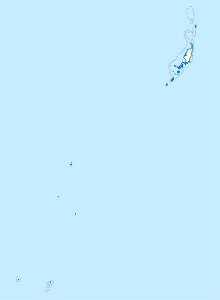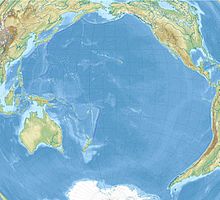
Back معركة بيليليو Arabic پللیو دؤیوشو AZB Бітва за Пелеліу Byelorussian Emgann Peleliu Breton Batalla de Peleliu Catalan Bitva o Peleliu Czech Schlacht um Peleliu German Batalo de Peleliu Esperanto Batalla de Peleliu Spanish Peleliuko gudua Basque
| Battle of Peleliu | |||||||
|---|---|---|---|---|---|---|---|
| Part of the Mariana and Palau Islands campaign of the Pacific Theater (World War II) | |||||||
 The first wave of U.S. Marines in LVTs during the invasion of Peleliu on 15 September 1944. | |||||||
| |||||||
| Belligerents | |||||||
|
|
| ||||||
| Commanders and leaders | |||||||
|
William H. Rupertus Paul J. Mueller Roy Geiger Herman H. Hanneken Harold D. Harris Lewis B. Puller |
Kunio Nakagawa † Sadae Inoue | ||||||
| Units involved | |||||||
| Additional support units |
Peleliu garrison
| ||||||
| Strength | |||||||
| 47,561[1]: 36 |
10,900[1]: 37 17 tanks[2] | ||||||
| Casualties and losses | |||||||
|
Total Palau Group
Breakdown by locations |
Total Palau Group[9]
Breakdown by locations
| ||||||
The Battle of Peleliu, codenamed Operation Stalemate II by the US military, was fought between the United States and Japan during the Mariana and Palau Islands campaign of World War II, from 15 September to 27 November 1944, on the island of Peleliu.
US Marines of the 1st Marine Division and then soldiers of the US Army's 81st Infantry Division fought to capture an airfield on the small coral island of Peleliu. The battle was part of a larger offensive campaign known as Operation Forager, which ran from June to November 1944 in the Pacific Theater.
Major General William Rupertus, the commander of the 1st Marine Division, predicted that the island would be secured within four days.[10] However, after repeated Imperial Japanese Army defeats in previous island campaigns, Japan had developed new island-defense tactics and well-crafted fortifications, which allowed stiff resistance[11] and extended the battle to more than two months. The heavily outnumbered Japanese defenders put up such stiff resistance, often by fighting to the death in the Japanese Emperor's name, that the island became known in Japanese as the "Emperor's Island."[12]
In the US, it was a controversial battle because of the island's negligible strategic value and the high casualty rate, which exceeded that of all other amphibious operations during the Pacific War.[13] The National Museum of the Marine Corps called it "the bitterest battle of the war for the Marines".[14]
- ^ a b Cite error: The named reference
Moranwas invoked but never defined (see the help page). - ^ Taki. "The History of Batlles of Imperial Japanese Tanks". Plala (in Japanese). Retrieved 4 March 2018.
- ^ [1] Naval History and Heritage Command, "World War II casualties," citing "The Statistics of Diseases and Injuries. vol.3. Washington: Government Printing Office, 1950." Retrieved 2/10/23. "Invasion of Palau Islands: 1171 killed, 101 died of wounds, 1 died as a prisoner."
- ^ [2]"History of the USMC in World War II vol. IV: Western Pacific Operations p. 285, 797. Retrieved 2/10/23. Total for Peleliu island is 1,252 killed, DOW, MIAPD, and 5,274 wounded. Appendix H lists 1,050 killed, 250 died of wounds, 36 missing presumed dead, and 5,450 wounded, including many of those who later died.
- ^ [3]"History of the USMC in World War II vol. IV: Western Pacific Operations p. 285. Retrieved 2/10/23. Total Palau Group: 542 killed and 2,736 wounded or injured in action.
- ^ [4]"Casualty Report Number II" 8 May 1945, p. 65. Retrieved 2/10/23. 424 killed, 179 died of wounds, 9 missing in action, 2,313 wounded and injured in action
- ^ [5] Naval History and Heritage Command, "World War II casualties," citing "The Statistics of Diseases and Injuries. vol.3. Washington: Government Printing Office, 1950." Retrieved 2/10/23. "Invasion of Palau Islands, 185 killed, 10 died of wounds.
- ^ [6]"The History of the Medical Department of the United States Navy in World War II: The Statistics of Diseases and Injuries, Volume 3" p. 84. Retrieved 2/10/23. 699 total battle casualties - 185 killed and 10 died of wounds = 504 wounded and survived. The Marine Corps source linked above references 11, not 10, who died of wounds.
- ^ <ref>[7]"History of the USMC in World War II vol. IV: Western Pacific Operations p. 179, 253. Retrieved 2/10/23. According to American records, the Japanese lost more than 12,000 dead and 300 prisoners on the 3 main islands, excluding several dozen more who survived the initial battle and were captured or killed later.
- ^ Dean, Mack (9 May 2014). "Battle of Peleliu Facts". World War 2 Facts. Retrieved 14 January 2014.
- ^ Third Army blasts Nazi Strongholds. Universal Newsreel. 2 November 1944. Retrieved 21 February 2012.
- ^ Fackler, Martin (9 April 2015). "Ahead of World War II Anniversary, Questions Linger Over Stance of Japan's Premier". The New York Times. Archived from the original on 1 January 2022. Retrieved 8 August 2019.
- ^ Gypton, Jeremy (2004). "Bloody Peleliu: Unavoidable Yet Unnecessary". Military History Online. Military History Online, LLC. Archived from the original on 21 April 2021. Retrieved 4 March 2018.
- ^ "World War II: Central Pacific Campaigns: Peleliu". National Museum of the Marine Corps. Archived from the original on 3 March 2016. Retrieved 7 February 2012.
Cite error: There are <ref group=lower-alpha> tags or {{efn}} templates on this page, but the references will not show without a {{reflist|group=lower-alpha}} template or {{notelist}} template (see the help page).


